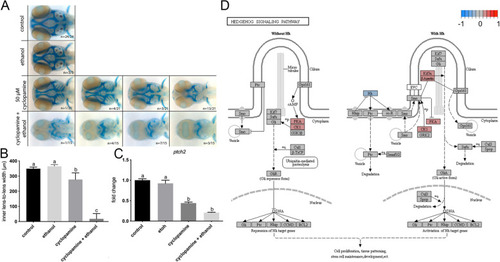
Ethanol indirectly attenuates Shh signaling. a Alcian blue and Alizarin red whole mount staining of 4 dpf control, cyclopamine-treated (50 μM), and ethanol- and cyclopamine-treated (1% ethanol plus 50 μM cyclopamine) wild-type embryos from 6 hpf to 4 dpf. Horizontal panels represent the spectrum of phenotypes observed for the treatment groups. Dorsal view, anterior to the left. b Quantification of the effect on inner lens-to-lens width. Both cyclopamine alone and cyclopamine and ethanol were significantly different from controls (p < 0.0001; Tukey’s honest test). Sample size and p values provided in Additional file 9: Table S2. c RT-qPCR of ptch2 in 10 hpf control and ethanol- and/or cyclopamine-treated wild-type embryos. n = 4, for all groups (p < 0.05; Tukey’s honest test). P values provided in Additional file 9: Table S2. d KEGG pathway schematic illustrating differential expression due to ethanol treatment in the sonic hedgehog (Shh) signaling pathway. Color coding indicates log2 fold differences due to ethanol treatment across all samples
|

